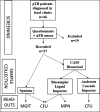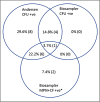Differentially culturable Mycobacterium tuberculosis in cough-generated aerosols of patients with pulmonary tuberculosis DCTB in cough-generated aerosols
- PMID: 40478621
- PMCID: PMC12144321
- DOI: 10.1099/jmm.0.002027
Differentially culturable Mycobacterium tuberculosis in cough-generated aerosols of patients with pulmonary tuberculosis DCTB in cough-generated aerosols
Abstract
Introduction. While Mycobacterium tuberculosis cells in sputum in sputum have been studied extensively, little is known of their properties in exhaled aerosols.Hypothesis. As differentially culturable tubercle bacteria (DCTB) are readily found in sputum, we hypothesized that DCTB might also be present in aerosols and potentially contribute to transmission.Aim. To test cough aerosols from recently diagnosed pulmonary tuberculosis (TB) patients for DCTB.Methodology. Cough-generated aerosols and sputum samples were collected from active pulmonary TB patients (n=27). A cough aerosol sampling system was modified to include both an Andersen Cascade Impactor using solid agar and a BioSampler liquid impactor. We performed the most probable number of assays to detect DCTB, using media supplemented with Mycobacterium tuberculosis culture filtrate (CF).Results. Briefly, 63% of patients (n=17) had advanced TB, and 55.6% (n=15) had a 3+ sputum smear for acid-fast bacilli. Evidence for DCTB was found in 8 patients' aerosols (29.5%) and more than half of the 19 sputum samples tested (n=10; 52.6%). Two patients had DCTB in only one of the collected samples (cough aerosols or sputum). Among cough aerosol specimens, two patients (7%) only had CF-dependent DCTB.Conclusion. We detected DCTB in sputum and evidence for their presence in cough samples from pulmonary TB patients. These data suggest that bacilli undetected by traditional mycobacterial cultures may be aerosolized from pulmonary TB patients.
Keywords: Mycobacterium tuberculosis; cough-generated aerosols; culturability; culture filtrate; differentially culturable.
Conflict of interest statement
This work was supported by a Boston University Integrated Biomedical Pilot Grant Program (to E.C.J.-L.), the National Institute of Allergy and Infectious Diseases at the National Institutes of Health award UO1 AI065663-01 (International Collaboration in Infectious Diseases Research) to J.J.E., TB research unit network award U19AI111276 to J.J.E. and funds from the Núcleo de Doenças Infecciosas, Universidade Federal do Espírito Santo. The funders had no role in study design, data collection and interpretation, or the decision to submit the work for publication. The content is solely the responsibility of the authors and does not necessarily represent the official views of the National Institutes of Health. The authors declare no conflicts of interest.
Figures


Similar articles
-
Detection and Quantification of Differentially Culturable Tubercle Bacteria in Sputum from Patients with Tuberculosis.Am J Respir Crit Care Med. 2016 Dec 15;194(12):1532-1540. doi: 10.1164/rccm.201604-0769OC. Am J Respir Crit Care Med. 2016. PMID: 27387272 Free PMC article.
-
Detection of differentially culturable tubercle bacteria in sputum from drug-resistant tuberculosis patients.Front Cell Infect Microbiol. 2022 Sep 9;12:949370. doi: 10.3389/fcimb.2022.949370. eCollection 2022. Front Cell Infect Microbiol. 2022. PMID: 36159642 Free PMC article.
-
Variability of infectious aerosols produced during coughing by patients with pulmonary tuberculosis.Am J Respir Crit Care Med. 2012 Sep 1;186(5):450-7. doi: 10.1164/rccm.201203-0444OC. Epub 2012 Jul 12. Am J Respir Crit Care Med. 2012. PMID: 22798319 Free PMC article.
-
Droplets, dust and guinea pigs: an historical review of tuberculosis transmission research, 1878-1940.Int J Tuberc Lung Dis. 2018 Sep 1;22(9):972-982. doi: 10.5588/ijtld.18.0173. Int J Tuberc Lung Dis. 2018. PMID: 30092861 Review.
-
Is cough really necessary for TB transmission?Tuberculosis (Edinb). 2019 Jul;117:31-35. doi: 10.1016/j.tube.2019.05.003. Epub 2019 May 28. Tuberculosis (Edinb). 2019. PMID: 31378265 Free PMC article. Review.
References
MeSH terms
Substances
LinkOut - more resources
Full Text Sources
Medical
Research Materials

